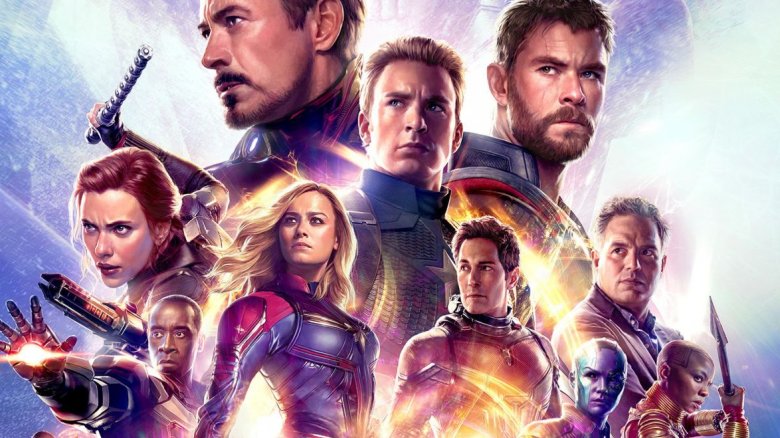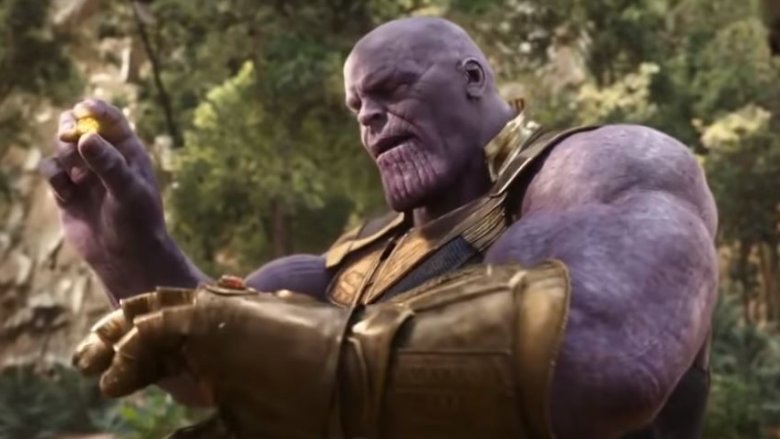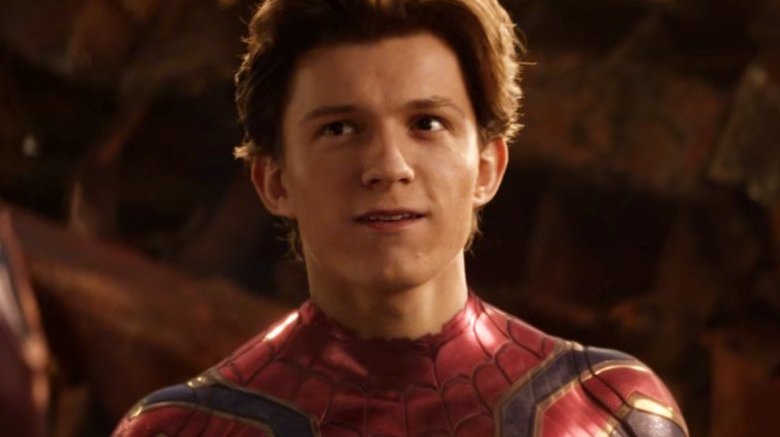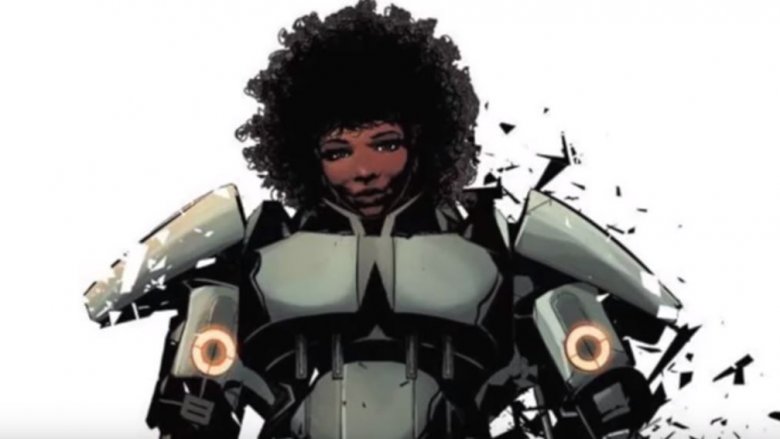The Untold Truth Of The Marvel Cinematic Universe
The past decade has been, without question, the Marvel Age of cinema. While plenty of blockbuster franchises have come and gone, you can't help but admire the scale and ambition of what the Marvel Cinematic Universe has become, from its unprecedented starting goal — bringing together multiple heroes to form the Avengers — to the even loftier realization of Avengers: Endgame, where more than 20 movies culminate in a battle for the universe. Seriously, has there ever been a more epic concept that actually came to fruition?
How did it all come together, though? While it certainly started within the small New York offices of Stan Lee, Jack Kirby, and Steve Ditko in the 1960s, it took decades of low-budget misfires before Marvel finally starting making good movies, and even longer before Kevin Feige, a crazy genius with an encyclopedic knowledge of comic book lore, decided it was time to buckle up, assemble the Avengers, and connect everything into the shared universe that has now revolutionized cinema. Here's the story behind the Marvel Cinematic Universe.
Kevin Feige's origin story came with the X-Men
These days, the original 2000 X-Men flick seems rather quaint, but there's no understating how much Bryan Singer's film paved the way for everything that followed. In an era where superhero movies were looked at as gaudy box office poison, X-Men's serious themes enthralled viewers, made the film a surprise success, and opened the door for more Marvel adaptations. Two years later, Sam Raimi's Spider-Man blew that door off its hinges.
One of X-Men's secret ingredients, according to Vanity Fair, was a freshman intern named Kevin Feige, who worked for producer Lauren Shuler Donner. Feige insisted that the movie should embrace its roots — for example, he pushed hard for an irritated hairstylist to give Hugh Jackman the classic pointed Wolverine hairdo that he finally wore in the film — and Feige's vast repository of comics knowledge soon got the attention of then-Marvel Studios head Avi Arad, who hired Feige as his new right hand man. Over the next few years, Arad sent Feige to the set of every Marvel production to help the filmmakers with comic book accuracy. The studios making these movies (Fox, Lionsgate, etc.) often didn't listen to Feige's advice — hence, movies like that awful 2003 Daredevil adaptation — but Feige kept plugging away. As the New York Times explains, Feige stood out at the fledgling company because of his deep Marvel knowledge and his innate understanding of how the film medium worked.
Second stringers save the genre
Before the MCU existed, Marvel didn't make their own films: They licensed their marquee characters — Spider-Man, the X-Men, the Fantastic Four, and so on — to big studios like Sony and Universal and prayed for good results. This arrangement meant that Marvel had little creative control over the blockbusters featuring their heroes, and according to the New York Times, they also didn't make much money off these films. By the mid-2000s, the situation for superhero movies worsened, thanks to an increasingly large collection of bad apples: For every success like Spider-Man 2, there were dumb cash-ins like My Super Ex-Girlfriend and The League of Extraordinary Gentlemen. Soon, comic book flicks were predicted to go the way of the Western. Industry analysts sounded the death bells.
Not Kevin Feige, though. According to Vanity Fair, Feige wanted to use the lesser-known characters Marvel Studios hadn't yet sold off the rights to — second stringers, basically — and make them into films by Marvel Studios, for Marvel Studios. To make matters even more ambitious, he wanted to bring them all together in a giant crossover film titled The Avengers. Now, imagine how crazy this sounded: Marvel wanted to make big-budget films featuring characters the general audience was somewhat unfamiliar with at a time when comic book movies were flopping all around and eventually bring them all together in one movie? Madness!
Nonetheless, Marvel Studios moved forward, eventually securing funding from Paramount Pictures.
The original MCU slate could've been way different
Who were these second stringers that Marvel Studios still had the rights to? Well, way back when Marvel first approached this whole concept, the first batch of heroes was going to look a whole lot different from what you know today, according to Screen Rant. As envisioned in 2005, the original slate of Marvel films was going to include the following: Captain America, Ant-Man, Nick Fury, Black Panther, Hawkeye, Cloak & Dagger, Doctor Strange, Shang-Chi, and ... uh, the Power Pack. Yeah.
Notice a particular name missing from that slate? That's right, Iron Man, the MCU's poster boy. Later that year, Tony Stark's rights returned to Marvel from New Line, swiftly followed by Black Widow, Hulk, and Thor. While none of these characters had the name recognition of, say, Wolverine, getting them back did lead to a far more comics-accurate Avengers lineup. With their assets recovered, Marvel decided that Iron Man would be their new launching pad.
Iron Man was a crazy surprise success
Now that Marvel rules the world, it's easy to forget that 2008's Iron Man was, when it came out, an experimental independent film that easily could have failed. Nobody expected it to change the world, and there was definitely no anticipation that it would launch a 20-plus-movie franchise filled with magic, aliens, mythological gods, and other cosmic shenanigans. To make matters more fraught, longtime Marvel leader Avi Arad left the company right before Iron Man came out, according to Vanity Fair, leaving Feige to take his place.
Well, you know what happened. Iron Man became an astonishing box office smash, earning rave reviews and paving the way for Hulk, Thor, and Captain America to follow in his footsteps. In 2012, The Avengers became the third highest grossing film in history and sent every studio in the world scrambling to develop their own cinematic universes. Most of these imitations didn't work out (here's looking at you, Universal's Dark Universe) because they rushed into Easter eggs and shared characters instead of replicating the skill, patience, and planning that Marvel employed for their own films.
Disney comes knocking
Meanwhile, the Walt Disney Company was seeing the limitations of only making kiddie flicks and endless Pirates of the Caribbean sequels, so they wanted to scoop up a smaller studio to make big tentpole films for them. When Iron Man, Thor, and their friends appeared out of nowhere, the Mouse House acted quickly, buying Marvel Studios for $4 billion, according to Vanity Fair. At the time, fans panicked about how this acquisition might ruin Marvel, with social media swamped with memes of the Punisher being kiddified into Mickey Mouse. Looking back, though, the arrangement continues to work out well for both parties, largely because Disney has allowed Marvel Studios to do its own thing.
In 2019, Disney went one step further, acquiring 20th Century Fox for $71.3 billion and bringing the X-Men, Silver Surfer, and Fantastic Four back to the Marvel family. There are also lots of other potential consequences of the merger, but that's a topic for another day.
How Joss Whedon brought in Thanos (and the Russos figured him out)
The post-credits stinger at the end of Iron Man, where Nick Fury walks into Tony Stark's house and talks about the Avengers Initiative, is usually cited as the moment where the Marvel Cinematic Universe truly began. Almost as impactful, though, is that bit at the end of The Avengers, where a strange purple dude seems uncomfortably pleased with the whole notion of "courting death." While this scene made every comic geek in the world squeal with excitement, casual fans needed to do some research to figure out that Thanos was being positioned as the big bad of the entire MCU.
But Thanos wasn't part of the original MCU plan. According to Slash Film, it was Avengers director Joss Whedon who first proposed throwing the philosophical alien warlord into the end of the film as the mastermind behind Loki's ill-fated invasion, while Feige simply gave him the go-ahead.
However, once Whedon had thrown that giant purple elephant into the room, he wasn't quite sure how to handle it. Years later, Whedon admitted to IGN that the proposition of delving into Thanos so intimidated him that he simply punted the task off to the next directors, the Russo brothers. Thanos is a complex, larger-than-life character who would've never worked without exactly the right approach, and luckily, the Russos pulled him off so marvelously that even the character's comic creator Jim Starlin was impressed, according to CBR.
The civil war off-screen
Ever wonder why there was almost no Black Widow merchandise during the early Avengers years? The fault lies with Marvel's then-CEO Ike Perlmutter. The details of Perlmutter's obnoxiousness are long and tedious, but basically, he's the micromanaging boss who criticizes everything, always wants to cut costs, and has no passion for the project itself. You know the type.
Throughout the early days of Marvel Studios, Perlmutter was always shooting Feige down. Meanwhile, Feige also kept being roadblocked by the so-called "Marvel Creative Committee," according to Collider, a group of comic book professionals who continually thwarted the creative input of Marvel's directors. (For example, they wanted James Gunn to ditch his groovy Guardians of the Galaxy soundtrack.) This messy structure forced Feige to spend all his time trying to please both Perlmutter and the Creative Committee, instead of just making great movies.
Captain America: Civil War was the turning point, as Feige's epic plans for the Avenger-versus-Avenger movie kept colliding with the penny-pinching suggestions of both Perlmutter and the Creative Committee. In response, Feige threatened to leave the company — and thankfully, Disney took notice, by ditching the Creative Committee and restructuring Marvel so Feige only had to report to Disney's CEO, bypassing Perlmutter altogether.
Guess what happened, once Feige shook the leash? Marvel's films got way bolder, better, and more experimental. See Black Panther, Thor: Ragnarok, and Avengers: Infinity War.
How Spider-Man came home
For years, the notion of seeing Spidey get tangled up with his Marvel brethren seemed like an impossible dream: Sony has had the Spider-Man rights for decades, and why would they be stupid enough to let them go? Then suddenly, Tom Holland arrived, webbing up Cap's shield, and making it seem like Marvel had finally recollected its biggest property.
Well, here's the thing. Marvel still doesn't own Spider-Man's film rights, but they worked out a quirky deal with Sony to use him. As the Hollywood Reporter explains, it all started when Sony was disappointed by lackluster reception for The Amazing Spider-Man 2. Meanwhile, the MCU was going like crazy, so Feige proposed a deal: Marvel would provide creative direction for a new version of Peter Parker, with the character based in the MCU, but would let Sony keep the profits — as long as they got to use Spidey in their own films, as well.
As Variety explains, this works out well for both parties. Marvel gets to incorporate its biggest hero, Sony gets to profit off the MCU phenomenon, and everybody's happy.
How Samuel Jackson became Nick Fury
Just like your dad's corny old jokes sometimes need an upgrade, Marvel Comics wanted to revamp their characters in the early 2000s. The most iconic evolution from Marvel's so-called "Ultimate" line proved to be Mark Millar and Bryan Hitch's new version of Nick Fury. No longer a cranky old white guy, the new Fury was a smooth badass who looked and acted ... well, a whole lot like Samuel L. Jackson. The inspiration was so obvious that one comic even had Fury saying that Jackson would be the perfect actor to portray him in a movie. Fourth wall, much?
Well, nobody knew that Jackson was actually a big comics fan, and he was paying attention. The actor discovered the bit in an L.A. comic shop in 2002, and according to Bleeding Cool, this prompted him to call his agent, who called Marvel, who apologetically admitted that they were hoping to cast Jackson when (or if) Fury ever appeared in the movies. Luckily for them, Jackson loved the idea, and he finally made his Fury-ious debut in 2008.
Years later, Mark Millar apologized to Jackson for exploiting his appearance, according to Business Insider. Jackson shrugged it off, saying, "F**k no, man. Thanks for the nine-picture deal."
Yes, Marvel has all kinds of crazy scripts, but that doesn't mean they'll become movies
These days, Marvel has gotten the rights back to most of their characters and has proven that even the most unknown heroes can become box office smashes. So, not surprisingly, they commission a lot of scripts, and when word gets out, fans go crazy with speculation. However, it's important to recognize that Marvel commissions these scripts mostly as a way to generate concepts, and many of them will never become films — remember that War Machine movie that never happened? — so fans shouldn't get too excited if, say, somebody writes a Son of Satan script someday.
Still, it's fun to hear about the unproduced scripts Marvel is sitting on. For example, the Hollywood Reporter mentioned back in 2013 that there's a Blade script floating around. Vampires in the MCU! Meanwhile, Jada Rodriguez apparently wrote a really awesome script for Ironheart, according to ComicBook.com, who is a young female successor to Iron Man. Also, ThatHashtagShow reported in 2018 that the studio had commissioned a script for "Dark Avengers," a property that — in the comics — sees villains like Venom, Bullseye, Daken, and the Green Goblin disguising themselves as popular heroes. Hey, maybe it could be like Suicide Squad, except less lousy?
Why did Netflix dump its Marvel shows?
Back in the early days of Marvel and Netflix's partnership, it seemed like a deal made in heaven. But then in 2018, Netflix canceled all its Marvel shows, without warning, leaving cliffhangers galore.
Why? According to Forbes, Netflix's decision to go all double-Thanos on its Marvel programming was largely a power move. Though the Marvel shows pulled in good ratings, Netflix doesn't want to be indebted to third-party content anymore, instead preferring to rely on original programming they hold the full rights to. Good for Netflix's business plans? Sure, but it sucks for Marvel fans, who are still rallying for Netflix to un-cancel the shows via campaigns like #SaveDaredevil. To make matters worse, Indie Wire says the original Netflix/Marvel contract reportedly holds a clause stipulating that any Marvel characters who appeared on a Netflix show can't even enter development with anyone else for at least two years following any show's cancellation. If true we'll be waiting until 2020 or later to see players like Luke Cage, Jessica Jones, or the Punisher back in the mix.
Don't count on seeing the X-Men anytime soon
The Disney/Fox merger could have a huge impact on non-MCU things, but one silver lining is that Marvel Studios finally has the rights back to all the characters Fox was keeping away from them. This includes the Fantastic Four, Doctor Doom, Galactus, the Silver Surfer, and the X-Men. Yes, someday in the future, Spider-Man could hang out with Iceman at Xavier's School for Gifted Youngsters, Storm could summon rainclouds over Sokovia, and Wolverine might even pop his claws in a battle against the incredible Hulk!
...but not anytime soon. Kevin Feige has cautioned fans that it will be a "very long time" before the X-Men start clawing, bamfing, or phasing their way into the MCU, and honestly, that's for the best. Right now, people are still shedding tears over Logan's heartbreaking conclusion, and Xavier's mutant squad deserves a good, long vacation before they get rebooted again. In the meantime, fans can look forward to MCU films for Black Widow, The Eternals, and Shang-Chi, as well sequels to Black Panther, Doctor Strange, and Captain Marvel.
However, when the X-Men do finally debut in the MCU, the story of Kevin Feige's rise to the top — from doing Wolverine's hair in 2000, to masterminding the entire Marvel Cinematic Universe — will finally come full circle. Face front, true believers!












